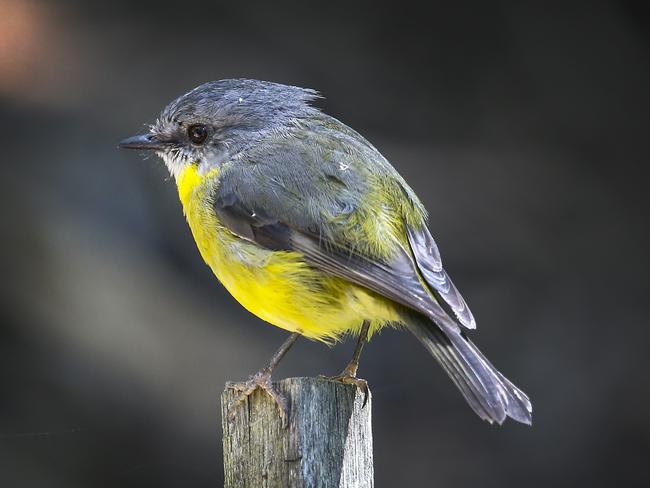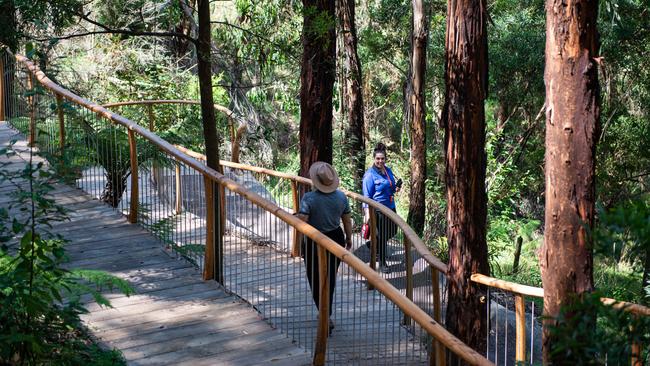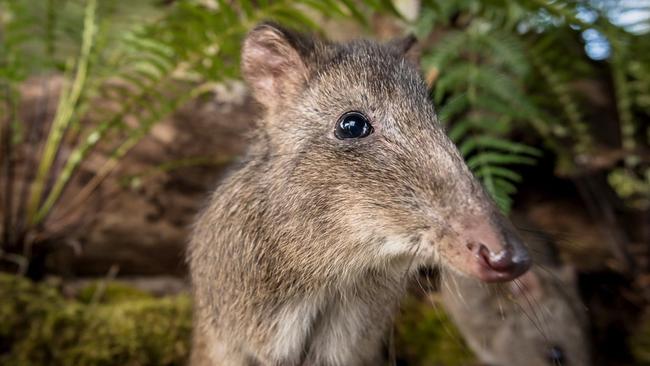Wildlife sanctuary protect native animals from feral cats, foxes
A new wildlife sanctuary in Victoria is keeping native animals out of harm’s way.

The mist rolls in over the Southern Ocean and rises to meet the forested hills of Victoria’s Otway Ranges, drowning the canopies of mighty mountain ash trees. It’s a scene that’s almost primordial; the temperate rainforest rears straight out of the sea behind the Great Ocean Road and floods inland like a dark green tsunami. I’m driving to the coast from the aptly named inland town of Forrest, but in a sense I’m also driving back in time, getting a glimpse of what this wild, southern stretch of Victoria would have looked like before European settlement.
It’s a fitting way to arrive at my destination, because recreating the Victoria we’ve largely lost is one of the goals at Wildlife Wonders, a native animal sanctuary 5km west of Apollo Bay that opened its doors in March. It’s the latest project for the Conservation Ecology Centre, a not-for-profit organisation achieving wonders not just here but throughout the Otways. Protected by a 1.4km long perimeter fence, native animals are safe from the feral predators that have devastated biodiversity not just here but throughout mainland Australia. It offers a snapshot of the Otways landscape as it was and as it should be, while raising money for ongoing conservation and research work.

I’m taking one of Wildlife Wonders’ first tours, a 75-minute guided walk through a rehabilitated landscape that not long ago was a sheep paddock bounded by blackberry-infested gullies. A Landcare revegetation project was started here 25 years ago, and the rejuvenation is remarkable. It’s still early days in the scheme of things, but the eucalypts are already shooting skywards, providing habitat for koalas, possums and birds, while lush fern gullies provide sheltered protection for pobblebonk frogs and shy bandicoots and potoroos. With time, the bush will spread and become denser, more animals will move in and the vision will become complete. But seeing it in its infancy is special.
The experience was designed by Brian Massey, art director on The Hobbit and greensmaster (in charge of greenery and landscaping) for The Lord of the Rings films, as well as being the brains behind New Zealand’s award-winning Hobbiton attraction.

Massey’s sympathetic and evocative landscape design is reflected in the way the path snakes down the hill, following natural contours between trees and letting the landscape unfold. The smooth Cyprus pine handrails look like they’ve been designed by industrious woodland creatures with an eye for the magical, periodically plunging into the earth, so that the path becomes part of the forest.
Our guide, Taz, is an avid birder and it’s not long before she spots a white-throated tree creeper living up to its name, spiralling up a eucalypt trunk foraging for insects in the bark. Silence soon gives way to cacophony as the canopies come alive with a gang of gang-gang cockatoos, their characteristic “creaky door” calls echoing through the bush in surround sound. Keen eyes spot koalas dozing high in the trees, while at ground level we spy the telltale blue-strewn decorations of a bower belonging to a houseproud male satin bowerbird. An eastern yellow robin flits around in the understorey and, somewhere unseen deep within the foliage, one of our great forest songsters, the grey shrike-thrush, whistles its liquidly rich notes. Perhaps loveliest of all though is seeing what must be nature’s most maternal plant, the mother shield fern, which raises its young on the tips of its emerald-green fronds, gently lowering its youngster into the soil to go it alone when it becomes too heavy to carry. Don’t we just know the feeling?

In years to come the vegetation will grow to obscure the fence, which is visible for much of our walk and gives the feeling of being inside a penitentiary at times. but you could argue that’s kind of the point: we’re getting a vivid reminder of the sad lengths we have to go to in order to protect native animals from the ravages of foxes and cats.
Introduced feral predators are the number one reason Australia’s mainland has been largely wiped clean of the small digging marsupials known as “ecosystem engineers”. The tireless tilling of animals such as bettongs, potoroos, bilbies and bandicoots has aerated our soils for millennia, burying fuel load and spreading the fungi spores that trees rely on to form subterranean communication networks and receive nutrients. Long-nosed potoroos have been released at Wildlife Wonders, along with red-shouldered wallabies, swamp wallabies, red-bellied pademelons and southern bandicoots. Eastern bettongs are on their way. Ecologists at CEC hope the reintroduction of these species within this safe haven will, in time, yield knowledge on how we can best restore their habitats and ecosystem health beyond the fence.
The fence, of course, doesn’t constrain the movement of birds, so it’s quite telling that so many native species have chosen this pocket of restored country to call home. It’s the same with koalas and the various possum and glider species that use the high branches of trees as habitat corridors, moving freely in and out of Wildlife Wonders. Unlike a zoo or an island ark, visitors never know exactly which animals will be visible on a given day.
The temperature drops as we descend further into the moist fern gullies. Taz explains how the presence of frogs is a bio-indicator of levels of environmental pollution. Nothing to worry about here in that case; our walk is accompanied by a constant croaking. We climb out of the forest and onto an exposed, grassy headland overlooking the sea. Hoods are pulled over heads as the rain increases. This is one of the wettest corners of the state — the Otway Ranges receives up to 1800mm of rain a year — but this wild headland wears it well, damp wallabies sitting squat in the silvery afternoon light and wispy spiderwebs glistening in the grass, water droplets strung like fairy lights. Our walk ends with a dramatic vista of the coastline southwest to Blanket Bay and Cape Otway and, beyond, the moody ocean melding seamlessly into the sky.
With winter will come whales, and with time the native tussock grass will overrun the pasture grass and this old, scraggly sheep paddock will take another step forward in its march back through time.

More to the story
Wildlife Wonders plays the dual role of engaging the community in conservation, and funding ongoing CEC conservation projects throughout the Otways. One of those is looking at potoroos and fire, examining the animals’ movements before, during and after a planned burn and studying the resulting predation that occurs on the fire scars. So far the news isn’t good. The potoroos are surviving fire but falling prey to foxes afterwards. It reinforces how important experiences such as Wildlife Wonders are, not just for protecting vulnerable species that don’t stand a chance in the wild, but for raising funds to tackle the problem, and for showing visitors the true wonders of wildlife.
In the know
Wildlife Wonders is open daily, with tours departing on the hour. Booking is strongly recommended to avoid wait times. The cafe is open 9am-4.30pm (10am-3.30pm for hot meals). Tours are $59 an adult and $24 a child and include binoculars, headsets and raincoats.
Ricky French was a guest of Visit Victoria.

To join the conversation, please log in. Don't have an account? Register
Join the conversation, you are commenting as Logout